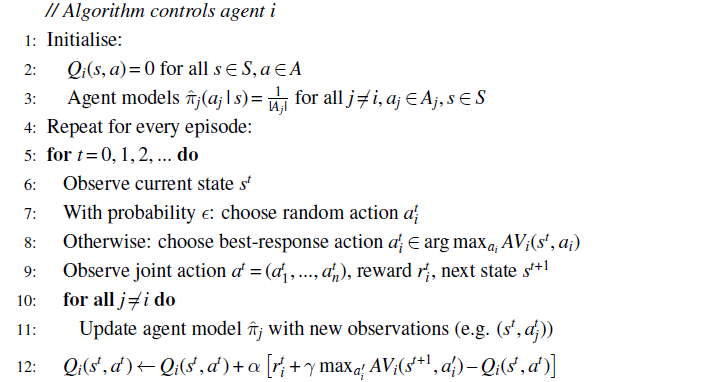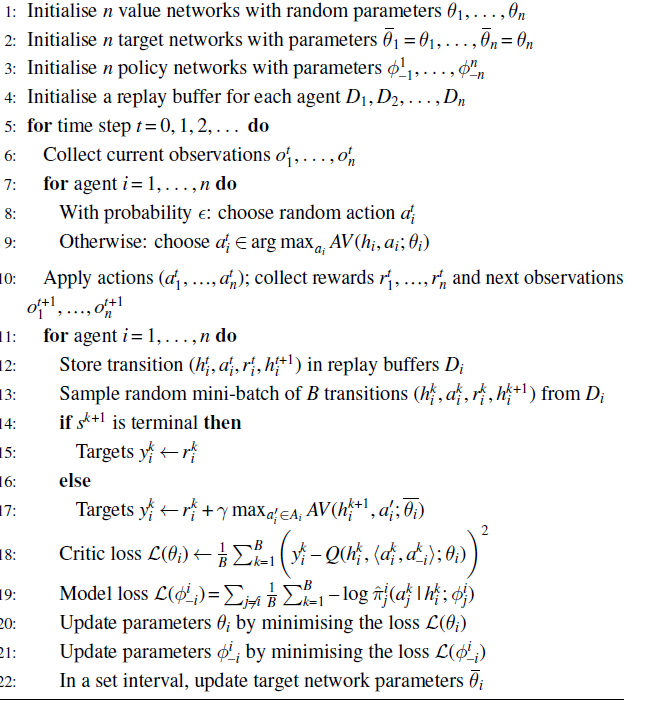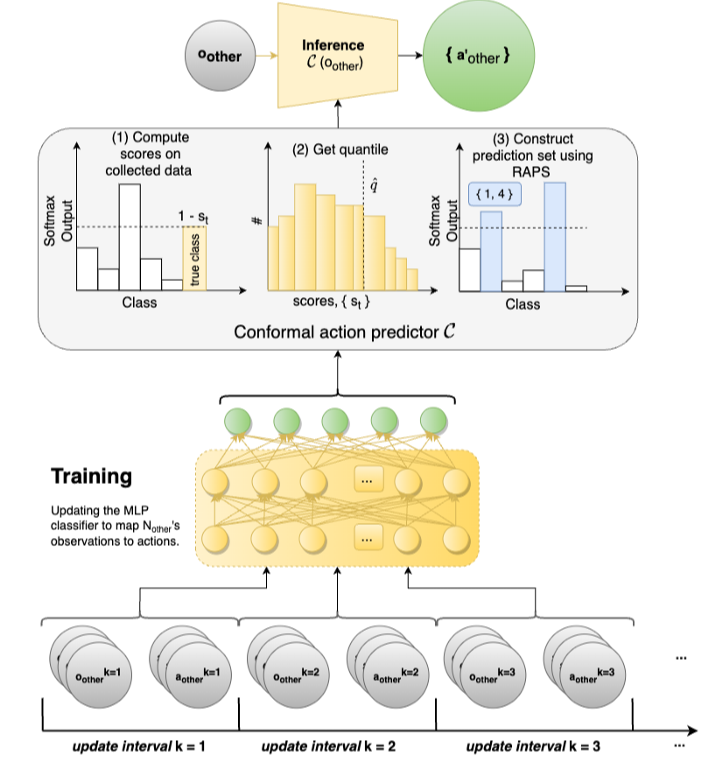-
Agent modeling is the task of learning explicit models of other agents to predict their own actions based on their past chosen actions
-
Rationale: Agents may take off-equilibrium actions for which the policy suggested in something like Joint Action Learning would not prescribe any action.
-
Policy Reconstruction - the goal is to learn models
of the policies of the other agents. - This can be framed as a Supervised Learning problem with the past observed state-action pairs of the modelled agent as input and the output being a new action
. - The agent then selects a best response policy using these models
- This can be framed as a Supervised Learning problem with the past observed state-action pairs of the modelled agent as input and the output being a new action
Classic Approaches
Fictitious Play
-
In fictitious play each agent models the policy of other agents as a stationary probability distribution
estimated from the empirical distribution of agent ’s past actions. -
It is defined for non-repeated games
-
More formally if
be the number of times was selected by agent , then For convenience, we may assume that the initial distribution is a uniform distribution.
-
In each episode, the best response action is chosen given by
-
Fictitious play gives optimal actions; it cannot give a stochastic policy. However, fictitious play can converge to random equilibria.
- If the agents’ actions converge, then the converged actions form a Nash equilibrium
- If in any episode the agents’ actions form a Nash equilibrium, then they will remain in the equilibrium in all subsequent episodes.
- If the empirical distribution of each agent’s actions converges, then the distributions converge to a Nash equilibrium of the game.
- The empirical distributions converge in several game classes, including in two-agent zero-sum games with finite action sets
- For games done repeatedly, the agent will only consider the current interaction
- For repeated games, the action may depend on past history
JAL-AM
- Combines Joint-Action Learning with Agent Modeling
- Here agents learn empirical distributions based on past actions and conditioned on the state
-
denotes the expected return to agent for taking action . 1

- Like AM, it returns best response actions.
- JAL-AM does not require observing the rewards of other agents.
Bayesian Learning
-
Extends Fictitious Play and JAL-AM by incorporating uncertainty and considering a distribution of models rather than a single model. The choice of models is governed by beliefs.
-
The goal is to maximize over beliefs, and in particular, compute the best-response action that maximize the value of information.
-
The value of information evaluates how the outcomes of an action may influence the agent’s belief.
- Rationale: Some actions may reveal more information about the policies of other agents than others .We are effectively using the framework described here.
-
Let
be the space of possible agent models for agent and where each model chooses based on the interaction history . After observing agent
’s action in state , we update using a Bayesian posterior distribution (shown below is the numerator but it needs to be normalized afterward) -
The value of information is then calculated using the following 2
- The agent then selects the action
DNN-based Approaches
- The goal is to learn generalizable models of the policies of other networks using deep neural nets.
- This is applicable especially when we have decentralized execution and where agents only have access to local observation history.
JAL with Deep Agent Models
-
Extends JAL-AM. Here, each agent’s model is a Neural Network
-
The agent model is learnt using the past actions of the other agents and the observation history. This is encapsulated in the following loss function
-
We define the action value as follows. An approximation to make it more tractable is also given using a sample of
joint actions from the models of all other agents. -
Each agent also trains a centralized action value

- Using the sampling approximation for
Policy Reconstruction
-
Rationale: It may not be feasible to use the policies and value functions of the other agents, even with using a model. This is because
- We may be running on decentralized execution
- The policies of the agents may be too complex.
- The policies of the agents change during learning.
-
One common approach is to use Encoder-Decoder Network. We may also use transformers. We have two networks
- The encoder
- The decoder gives action probabilities
- The encoder
-
The encoder-decoder networks are jointly trained using cross-entropy loss.
-
Other approaches such as those here can be augmented by conditioning on the learnt representation
Extensions
- Recursive Reasoning - an extension of agent modeling where agents consider how other agents might react to their decision making, or how their actions might affect the learning of other agents
- Opponent Shaping - an extension where agents try to shape their opponents — leveraging the fact that other agents are learning and exploiting this objective.
Research
-
3 develops a method to determine the intentions of other agents in the environment and determines whether or not to cooperate or compete, leading to the emergence of social norms.
-
The paper aims to bridge high-level strategic decision making over abstract social goals such as cooperation and competition with low-level planning over realizing these goals.. This is done through hierarchical social planning where learning is done on both levels
-
Low-level learning has two modes — cooperative and competitive High-level learning decides whether to cooperate or compete.
-
Cooperation is achieved through a group utility function
- A high level policy will be conditioned on the joint actions. Low level policies of each agent marginalize out the actions of the other player from the joint policy.
- Policies contain intertwined intentions. Cooperation is built as part of planning.
- Agents interact and after each interaction infer how much they weigh the utility of the other agent. This is akin to a form of virtual bargaining
-
Competition is achieved through maximizing individual utility
- A hierarchy is established with level-
- Two mechanisms are implemented — a model-based approach which is standard agent modeling, and a model-free approach for maximizing the agent’s own goals
- A hierarchy is established with level-
-
For higher level strategic learning, planning considers player’s intentions to cooperate or compete.
-
-
4 proposes CAMMARL, a MARL agent-modeling approach which models the actions of other agents using conformal prediction
-
At each time step, we use a conformal prediction model, defined as
-
Let
𝟙 And the rank as
Then the predictive action set is estimated as follows
Where
-
Inference using this method favors smaller set sizes which implies the model learns to refine the conformal prediction.
-
Limitation: The model assumes that the state space is accessible globally.
-
Limitation: The results of the paper are based on a simple two-player environment.
-


Links
-
Albrecht, Christianos, and Schafer - Ch 6.3, 9.6
Footnotes
-
This is essentially the best response action except using
-
In effect, value of information is an extension of the regular state-based value function
-
Weiner et al. (2016) Coordinate to cooperate or compete: Abstract goals and joint intentions in social interaction ↩
-
Gupta, Nath and Kahou (2023) CAMMARL: Conformal Action Modeling in Multi Agent Reinforcement Learning ↩